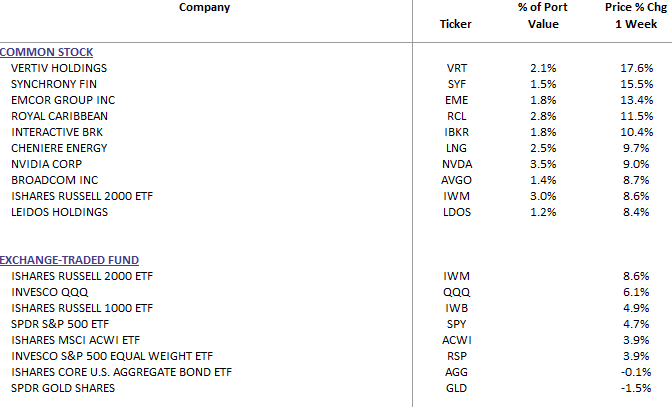Weekly Commentary for the week ending November 9, 2024
Market Week in Review: Record Highs Amid Strong Economic Signals and Post-Election Rally
The latest performance in U.S. equities and economic indicators highlights a dynamic interplay of market drivers in response to recent political and economic developments. The past week saw the S&P 500 and Nasdaq setting new record highs, while the Russell 2000 posted its strongest week since March 2020. This rally was broad-based, with all sectors gaining ground; however, certain sectors and industries exhibited standout performances.
.
WealthTrust Long Term Growth Portfolio Weekly Top 10 Holdings
It should be noted that VRT, SYF, EME, and IBKR were identified utilizing our Generative A.I Momentum methodology verified by our historical 22 year Quantitative and Fundamental Analysis.
Key Market Drivers
Trump’s Election Victory Impact
The recent election outcome catalyzed a substantial rally in risk assets, particularly benefiting sectors such as banking, credit cards, machinery, and even cryptocurrency. Banks, including major indices like the BKX and KRX, surged 8.4% and 10.9% respectively, as investors anticipate a lighter regulatory environment. Trump's pro-business stance, highlighted by a proposed reduction in the corporate tax rate from 21% to 15%, bolstered confidence across sectors. Goldman Sachs forecasts that this tax cut could add approximately 4% to S&P 500 earnings, reinforcing the positive sentiment in the equity markets.
The renewed market vigor also stemmed from a reduction in election-related uncertainty. With a clearer political outlook, volatility indices like the VIX and MOVE retreated, allowing for more systematic fund flows into equities. Nomura estimated $50 billion in U.S. share purchases by volatility-controlled funds in the coming month, while the end of the buyback blackout period could add $25-$50 billion in corporate repurchases through year-end.
Treasury Yields and the Dollar
Treasuries experienced notable moves, with the curve flattening slightly; the short-end yields ticked higher while the long end firmed. Despite fears of inflationary pressures from Trump’s potential fiscal policies, such as tariff imposition and budgetary adjustments, expectations around the speed of implementation have tempered bond market reactions. These dynamics led to a firmer dollar, marking its sixth consecutive week of gains and hitting levels last seen mid-year. A stronger dollar, however, poses a potential headwind for U.S. multinationals, as every 2% appreciation is estimated to shave 1% from S&P 500 earnings growth. This underscores the balancing act faced by U.S. companies in a more competitive global environment.
Federal Reserve’s Stance and Economic Data
The Federal Reserve concluded its November meeting with a 25 basis point rate cut to a range of 4.5-4.75%, a move in line with expectations. Despite subtle changes in its inflation language, Chair Powell downplayed any shift in policy direction, leaving open possibilities based on upcoming data. The market is currently pricing a 30% chance of a pause in December, with the trajectory of cuts next year moderated to just two anticipated cuts, down from four as recently as October.
This week’s economic data provided a mixed but overall optimistic picture. The University of Michigan consumer sentiment index reached a six-month high, while ISM Services showed accelerating employment and cooled prices. Both sets of data underscore a resilient consumer base, though lingering concerns over inflation and wage growth remain.
Sector Highlights and Earnings Insights
Big tech stole the spotlight, with TSLA up 29% and NVDA rising 9.1%, following NVDA’s addition to the Dow. Other outperforming sectors included aluminum, healthcare distributors, semiconductors, and airlines, reflecting a rotation into economically sensitive and cyclical areas. Underperformers were sectors with potential vulnerability to economic policy shifts, including dollar stores, China tech, agricultural chemicals, and consumer staples.
Earnings season provided further insights as 90% of the S&P 500 has reported for Q3, showing an impressive blended EPS growth rate of 5.3%, beating initial expectations. Key themes were strong AI-related tailwinds, as seen in PLTR’s remarkable 39.3% gain, and mixed trends in the semiconductor sector. Consumer sentiment was also reflected in earnings, with positive trends for some retail stocks, such as Ralph Lauren (up 12.6%) and Affirm (up 7.5%), while other discretionary names struggled under tariff-related caution.
Outlook: Inflation Data and Fed Commentary in Focus
Looking forward, next week’s economic calendar holds two pivotal data releases: October CPI and retail sales. CPI will shed light on inflation’s trajectory, with core inflation expected to remain steady, potentially influencing the Fed’s future policy path. Fed commentary from Governor Waller and Chair Powell will also provide additional context for market expectations.
The week’s strong market performance reflects a complex but favorable environment for U.S. equities. While post-election optimism and strategic tax policy expectations drive gains, investors must also navigate the implications of a stronger dollar, evolving trade policies, and upcoming Fed decisions. The balancing of these factors will be crucial as we move further into the final quarter of the year.


